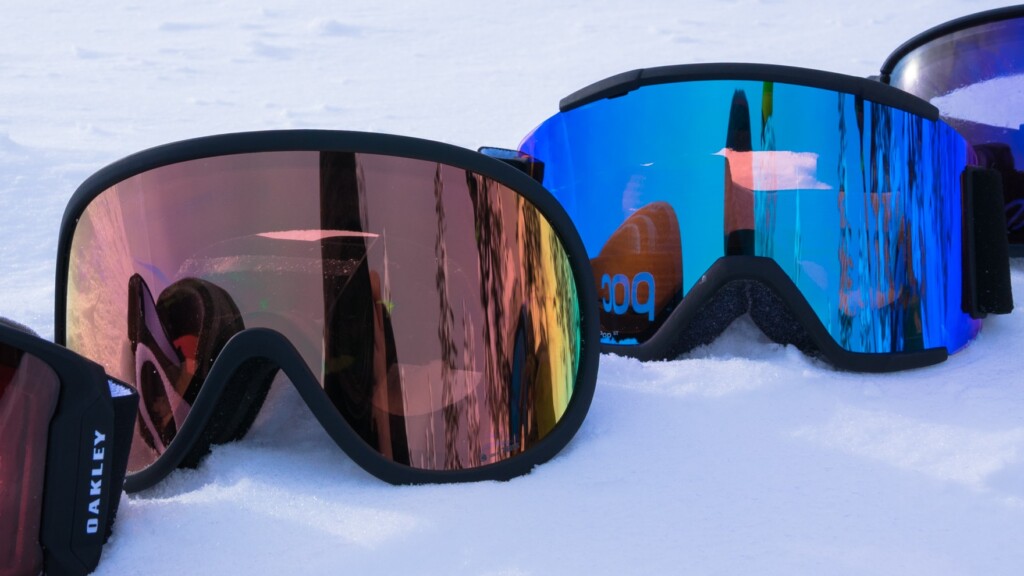
Comparison review: Even though it's cloudy, the snow surface is clear. Let's compare the rumored high contrast goggles for skiing and snowboarding.
From here, we will introduce recommended models based on specific points from various perspectives. Please use this if you want to judge your favorite model yourself based on the test results. He's quite a maniac, so if you like it, please try it.
table of contents
High brightness and contrast lens: OAKLEY
Here is a comparison of the performance of the high contrast lenses that caught my eye the most. To be honest, this is the part that we are focusing on the brand's most emphasis, and all of them have subtle pros and cons, and overall there are no models that stand out the best overall, making it a very troublesome choice .
First of all, in terms of the strength of the rumored high contrast (how clearly the shadows become easier to see), OAKLEY was the most obvious. It's clear on the slopes, but it's amazing how clear it is even in the city. Primary colors in particular look like fluorescent colors. SMITH has a strong contrast, even though the lens is bright. of POC and SWANS also appeared more clearly on the snow, but when looking at them in a complex environment, including in the city, they were slightly milder than the other two.
Next, in terms of lens brightness, the VLT is different so there is no exact difference, but in terms of a bright lens, the OAKLEY 's appearance in the sunny weather is the best, and the contrast is clear, making it brighter. Incidentally, SMITH is excellent in total brightness, and it looks bright, especially when it's dim. It feels brighter than your naked eyes. POCs and SWANS are basically bright and easy to see, and SWANS visible in colours that are close to the naked eye, so there is the least discomfort when worn.
High resolution and wide visibility: POC
On the other hand, when I put it on, my vision looked sharp and sharp . I can't explain the reason, but the lens made by CARL ZEISS, a camera lens manufacturer, certainly looked more clearly than the others. It feels like I've adjusted the image quality on my smartphone.
Finally, the wider view. The shape of the goggles and the shape of the frame have a major impact on the visible area. Naturally, it is easier to see if your vision is wider, but the easier it is to see the parts you need, the easier it is to use goggles. With this in mind, despite the flat lens, it was the POC The drooping shape, like teardrop sunglasses, gives a wide view of the left and right bottom parts, and also makes it easier to get a wide view in terms of the shape and size of the frame.
Cost performance: SMITH
It is easy to see, does not fog, and fit at a high standard, and the price (23,000 yen) for two lenses is simply good value for money. I've never bought goggles, or I can't use the goggles I'm currently using anymore. In such cases, I definitely recommend SMITH
Also, if you already have goggles that can be used, I recommend OAKLEY for the next one because of the careful construction.
Cloudy not easy: SMITH, OAKLEY
I think that not fogs are very important for enjoying powder in the backcountry. Therefore, this "cloudiness is not easy" was a consideration that I was particularly interested in.
Not only do they actually ski, but also leave it in the bath or spray it on, so there's no problem with either "SMITH or OAKLEY" as to whether it's not cloudy! It is not cloudy and absorbs and releases water very quickly, and even if it falls and snows get in, if you ride a single lift, it will recover to a level that is not a problem to watch. The POC was also not a problem with the fog on the inside. However, when I ride the gondola, I felt that the outside of the lens would be slightly cloudy.
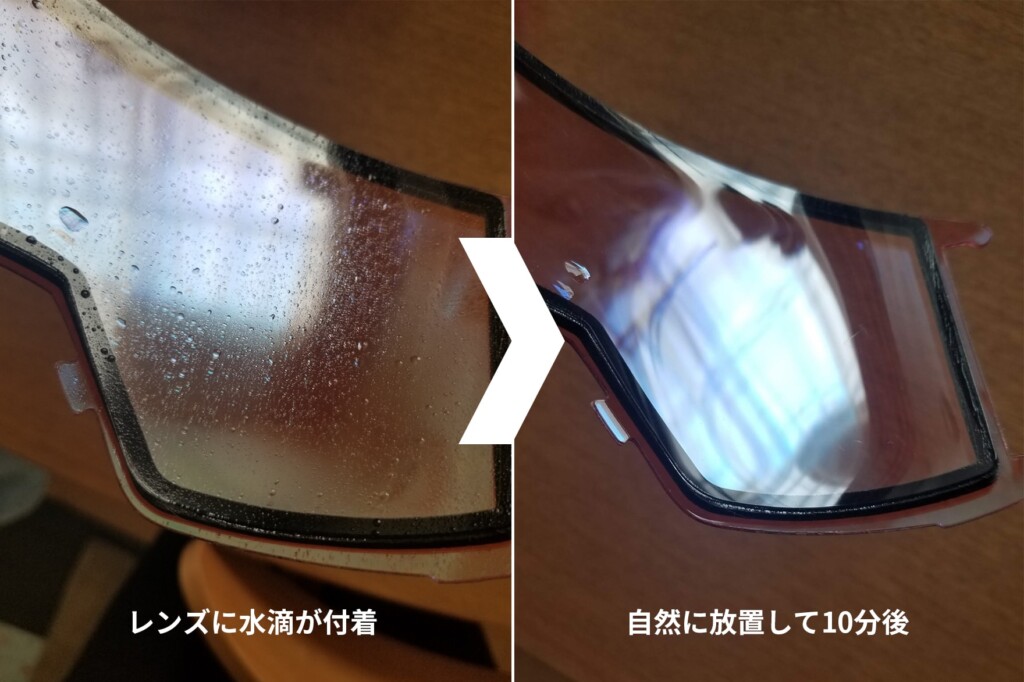
If the lens is not easily fogged, the lens will adsorb if it is slightly fogged, and even if you spray water with a spray bottle, it will absorb and dissipate the moisture immediately (photo is SMITH).
Regarding SWANS. I had no good impression of SWANS in the first place. However, following the results this time, my impression changed and I bought Swans goggles for my child. I had such a good impression of SWANS, but when it comes to using it in backcountry, I wouldn't recommend SWANS.
SWANS can cause snow to enter the inside, and when water droplets get on, the lens absorbs moisture and expands, making it difficult to see. Furthermore, once water is contained, it recovers slowly and the lens becomes distorted during this time. In this case, sub-goggles are essential.
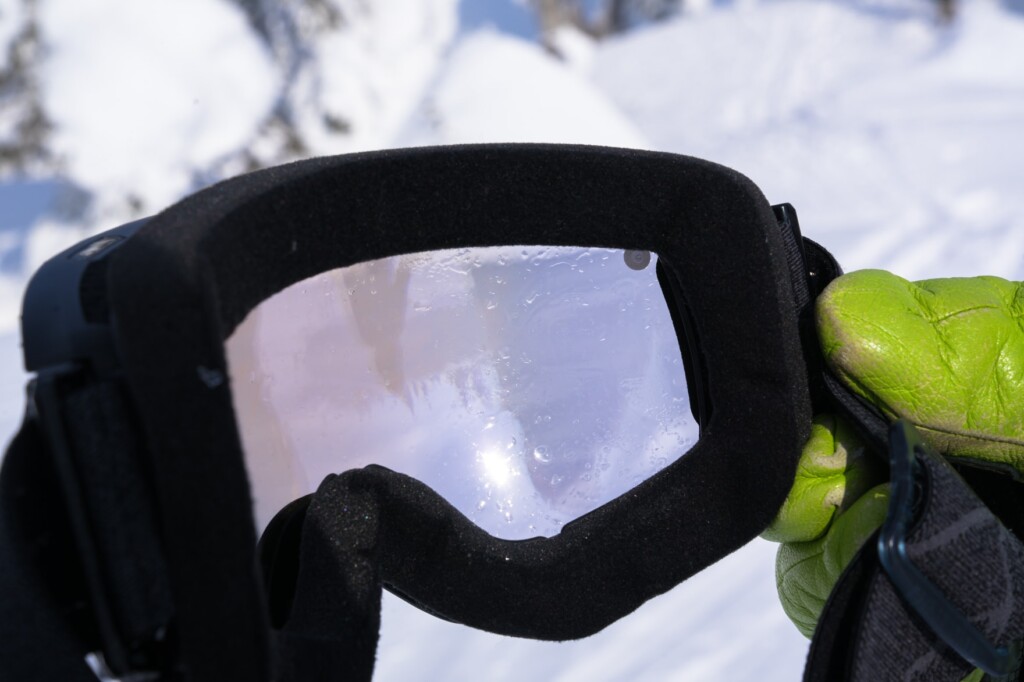
If moisture is adhered to the inside of the lens, the inside surface of the lens will become uneven like a crater. Of course, the vision is distorted. It takes a few minutes or even a few minutes to recover from this point.
Comfort: SMITH
(SMITH, OAKLEY, POC, SWANS from right)
the SMITH was the most comfortable overall, considering the fit, cushioning, and breathability . It's easier to see if you remove the lens and attach it with just the frame, but while other brands start touching it from the sides of the pads and around the temples, SMITH starts from the center. In other words, gaps are likely to form in the nose, and the curves of the face are looser than Westerners, making it easier to fit Japanese people. The reasons are that the nose part of the Japan Fit has a strong volume, and the foam pads are tapered with different thicknesses in the center and sides.
In addition, the OAKLEY is also very comfortable to wear due to its shape that is relatively easy for Japanese people to fit in, and the cushioning of the part that hits it. On the other hand, the POC is an Asian fit, the curve of the frame is still slightly tight, and the shape of the frame is likely to touch the cheeks, so there is a high chance that it will be a choice for someone to fit (although the nose pads are thick, so it's not a tight spot).
What about domestic SWANS Many people may think so. The SWANS has a loose curve, but the nose pads are actually thin. Because it is thin (especially in the nose), it may not suit some people.
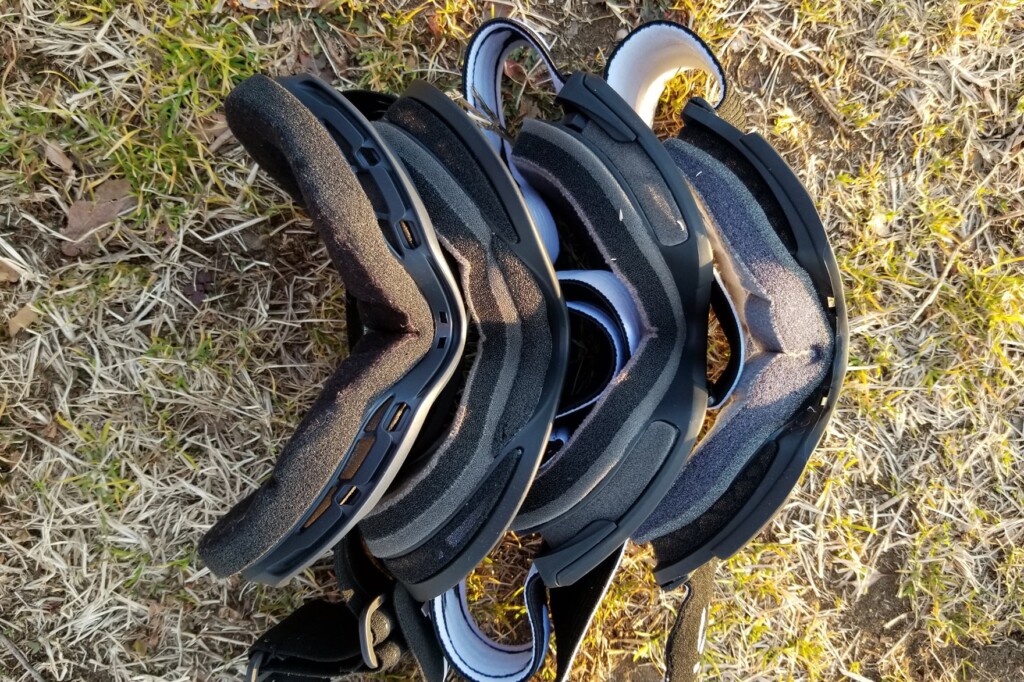
From the right: SMITH, OAKLEY, POC, SWANS. The thickness of the nose pads made the fit feel quite different.
Summary: Tips for choosing the perfect goggles for you, as we learned from the test
SMITH, OAKLEY, POC, and SWANS were all great products as they are top brands! The discussion was also very fun.
Based on the results of this article, we can say when choosing goggles:
- fitting
- Lens selection
is important. Finally, I would like to share some tips on how to choose from that I learned through this review.
1: Fitting
As for fitting, it has been said that fitting is important when choosing goggles. However, you may be wondering, "Where should I look at the fitting?" I've only ever been conscious of the gap in my nose. However, after testing this time, I found out that there are some points in the fitting as well.
- Is the frame size and size suitable for me?
- Does the curves of the frame form fit your face?
- Can't there be a gap in the nose?
- Don't you feel uncomfortable with the hardness of the foam and the feel of the material?
When choosing goggles, try trying out a variety of items, from expensive to cheap. Even if it's high, it's pointless if the fitting doesn't work.
If you try out 5-6 brands and models, you'll probably get it somehow. Especially when it comes to frame size and size, even if large lenses are popular, they look too childish, and if you wear a helmet, they can go well with a helmet. If it's too big, the goggles will be lowered to the helmet and won't fit.
Do you like or dislike the model? I think the most important thing is, but I hope you will remember the results of this time when you think, "Both this and this one are good, what should I do?"
2: Lens selection
Personally, I recommend choosing a lighter lens. In terms of VLT, it's around 35% to 50%. Basically, the lens covers the sun and cloudiness.
There are individual differences, but at 25% the lens color is too dark, which makes it difficult to see. The lenses aimed at foreigners, especially Westerners, seem too dark for Japanese people.
Foreigners, especially Westerners, wear sunglasses. It's fashion, but it's simply dazzling. Westerners are more sensitive to glare because their eyes are lighter.
It also snows well in Japan. It often snows and clouds in January and February, so I don't think you need a very thick lens.
With this lens,
- SWANS RIDGELINE-U (ULTRA lens VLT 35%)
- POC Retina Big Clarity (Spektris Rose Gold VLT 35%)
It seems like it's easy to use.

Left: SWANS RIDGELINE-U (ULTRA lens VLT 35%), Right: POC Retina Big Clarity (Spektris Rose Gold VLT 35%)
Of course, there are individual differences, so there is no absolute. In fact, I'm fine with bright lenses, so I prefer the SMITH Cromapop Storm Rose Flash lenz 50% lens.
However, when it's sunny, it's so bright that it's dazzling and annoying! There are also opinions like this.
Too bright, it's not good for your eyes and can get tired, so considering the average lens color, I think about 35% is safe. If you have the budget, this model didn't have one, but now there are lenses that are high contrast and also have dimmable lenses, so that's probably the best!
I think the best goggles will vary depending on how you use them and the situation you use them as your main focus. If we talk about this from the perspective of a backcountry skier, we get the results like this one.
I hope this will help you choose your goggles!
Hamaguchi Makoto
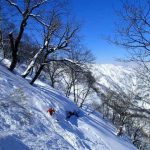 When I quit my job as an office worker and stayed at a ski resort, I became interested in powder riding after seeing friends who enjoyed powder. After that, I worked as a ski shop clerk before heading to my family's soba restaurant. In the summer we go to a soba restaurant. My goal is to work as a skier in the winter.
When I quit my job as an office worker and stayed at a ski resort, I became interested in powder riding after seeing friends who enjoyed powder. After that, I worked as a ski shop clerk before heading to my family's soba restaurant. In the summer we go to a soba restaurant. My goal is to work as a skier in the winter.
Looking for reviewers
Outdoor Gearzine is always looking for members who love the outdoors and would like to write reviews about outdoor equipment. For more information, please this REVIEWERS page !





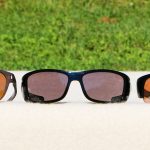 Comparative review: The world is different depending on whether it is "has" or "not". We've compared various sunglasses that can be used outdoors
Comparative review: The world is different depending on whether it is "has" or "not". We've compared various sunglasses that can be used outdoors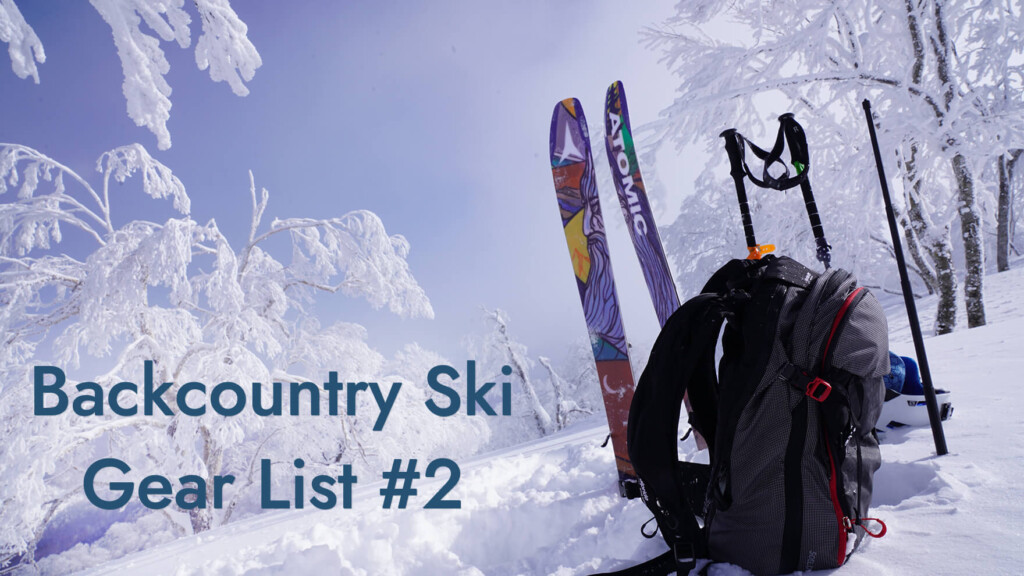 We'll be revealing the equipment list for the backcountry skis I've been using this season [Part 2]
We'll be revealing the equipment list for the backcountry skis I've been using this season [Part 2]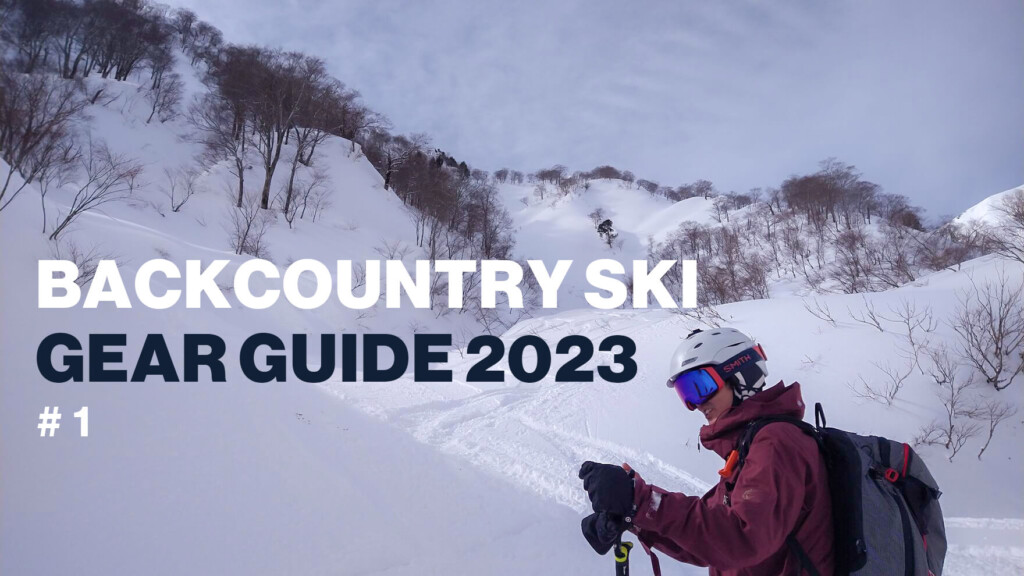 We'll be revealing the list of regular equipment this season in backcountry skiing Part 1 [To avoid being called reckless]
We'll be revealing the list of regular equipment this season in backcountry skiing Part 1 [To avoid being called reckless]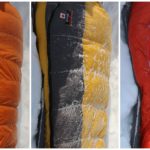 Comparison review: Winter Down Sleeping Bags Who did you get a warm, calm sleep even in the extremely cold winter mountains?
Comparison review: Winter Down Sleeping Bags Who did you get a warm, calm sleep even in the extremely cold winter mountains?